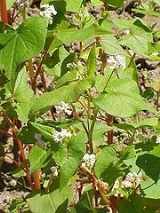
Fagopyrum
Encyclopedia
The genus
Fagopyrum in the flowering plant
family Polygonaceae
contains 15 to 16 species of plants, including two important crop plants, the Buckwheat
or Japanese Buckwheat Fagopyrum esculentum, and the Tartary Buckwheat
Fagopyrum tataricum. They have similar uses, and are classed as pseudocereal
s, i.e. they are used in the same way as cereal
s but do not belong to the grass
family Poaceae
.
Video Dock (Rumex) As Wild Edible Food Part 1 | Frank Cook
http://www.youtube.com/watch?v=Dib1zO5YNbM&feature=autoplay&list=ULUuBIoHflW38&index=8&playnext=1
Genus
In biology, a genus is a low-level taxonomic rank used in the biological classification of living and fossil organisms, which is an example of definition by genus and differentia...
Fagopyrum in the flowering plant
Flowering plant
The flowering plants , also known as Angiospermae or Magnoliophyta, are the most diverse group of land plants. Angiosperms are seed-producing plants like the gymnosperms and can be distinguished from the gymnosperms by a series of synapomorphies...
family Polygonaceae
Polygonaceae
Polygonaceae is a family of flowering plants known informally as the "knotweed family" or "smartweed family"— "buckwheat family" in the United States. The name is based on the genus Polygonum and was first used by Antoine Laurent de Jussieu in 1789 in his book, Genera Plantarum. The name refers...
contains 15 to 16 species of plants, including two important crop plants, the Buckwheat
Buckwheat
Buckwheat refers to a variety of plants in the dicot family Polygonaceae: the Eurasian genus Fagopyrum, the North American genus Eriogonum, and the Northern Hemisphere genus Fallopia. Either of the latter two may be referred to as "wild buckwheat"...
or Japanese Buckwheat Fagopyrum esculentum, and the Tartary Buckwheat
Tartary Buckwheat
Tartary Buckwheat is a domesticated food plant in the genus Fagopyrum in the family Polygonaceae. With its congener Common Buckwheat, it is often counted as a cereal, but unlike the true cereals the buckwheats are not members of the grass family. Thus they are not related to true wheat...
Fagopyrum tataricum. They have similar uses, and are classed as pseudocereal
Pseudocereal
Pseudocereals are broadleaf plants that are used in much the same way as cereals . Their seed can be ground into flour and otherwise used as cereals. Examples of pseudocereals are amaranth, Love-lies-bleeding, red amaranth, Prince-of-Wales-feather, quinoa, and buckwheat.- Pseudocereals :...
s, i.e. they are used in the same way as cereal
Cereal
Cereals are grasses cultivated for the edible components of their grain , composed of the endosperm, germ, and bran...
s but do not belong to the grass
Grass
Grasses, or more technically graminoids, are monocotyledonous, usually herbaceous plants with narrow leaves growing from the base. They include the "true grasses", of the Poaceae family, as well as the sedges and the rushes . The true grasses include cereals, bamboo and the grasses of lawns ...
family Poaceae
Poaceae
The Poaceae is a large and nearly ubiquitous family of flowering plants. Members of this family are commonly called grasses, although the term "grass" is also applied to plants that are not in the Poaceae lineage, including the rushes and sedges...
.
External links
- Jepson Manual Treatment
- USDA Plants Profile
- Flora of North America Profile
- Fagopyrum Journal Archive
Video Dock (Rumex) As Wild Edible Food Part 1 | Frank Cook
http://www.youtube.com/watch?v=Dib1zO5YNbM&feature=autoplay&list=ULUuBIoHflW38&index=8&playnext=1

